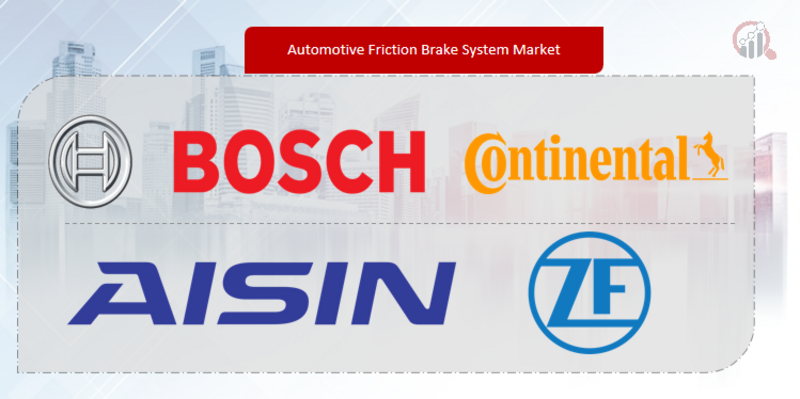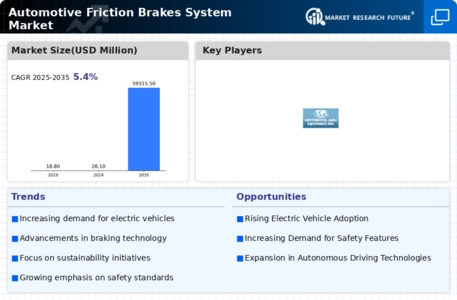Top Industry Leaders in the Automotive Friction Brake System Market

*Disclaimer: List of key companies in no particular order
Top listed global companies in the Automotive Friction Brake System industry are:
Brembo S.P.A, Continental AG, Delphi Automotive PLC, TRW Automotive Holdings Corp., Aisin-Seiki Co. Ltd., Federal-Mogul Corporation, Robert Bosch GmbH, Halla Mando Corporation, Haldex AB
Bridging the Gap by Exploring the Competitive Landscape of the Automotive Friction Brake System Top Players
The global automotive friction brake system market is a complex and dynamic space defined by established players, emerging innovators, and evolving trends. Understanding the competitive landscape is crucial for any company navigating this sector.
Key Players & Strategies:
Leading the pack are established giants like Bosch, Continental, and Brembo, boasting strong brand recognition, extensive global distribution networks, and diverse product portfolios encompassing both OEM and aftermarket segments. Their strategies often revolve around continuous technological advancements, strategic partnerships with automakers, and acquisitions to bolster market share and technological prowess. For instance, Bosch's acquisition of Knorr-Bremse's commercial vehicle braking division highlights their ambition to solidify their position in the heavy-duty segment.
Asian players like Akebono and Aisin Seiki are making their mark with competitive pricing and a focus on lightweight, high-performance brake materials. Their focus on regional growth, particularly in Southeast Asia, positions them advantageously in rapidly expanding markets.
Market Share Analysis:
Several factors influence market share analysis in this dynamic landscape:
- Product type: Disc brakes currently dominate, but market share for drum brakes remains significant in specific regions and vehicle segments.
- Vehicle type: Passenger cars account for the largest share, but growth in light commercial vehicles and electric vehicles presents new opportunities.
- Sales channel: Both OEM and aftermarket segments are crucial, with aftermarket players potentially gaining traction due to growing vehicle parc.
- Regional variations: Asia-Pacific is the largest and fastest-growing market, while Europe and North America continue to be prominent due to established infrastructure and stringent safety regulations.
New & Emerging Trends:
Several trends are shaping the competitive landscape:
- Electrification: Electric vehicles pose unique challenges for braking systems, prompting development of regenerative braking solutions and noise-reduction technologies. Companies like Brembo and TRW are actively pushing boundaries in this space.
- Sustainability: Eco-friendly materials and production processes are gaining traction, with a focus on reducing dust generation and incorporating recycled content. Aisin Seiki's development of organic friction materials exemplifies this trend.
- Advanced Driver-Assistance Systems (ADAS): Integration of ADAS with braking systems is creating new opportunities for automated emergency braking and adaptive cruise control features. Players like Bosch and Continental are at the forefront of this development.
- Data-driven insights: Utilizing data analytics to monitor braking performance and predict wear and tear is gaining traction, opening doors for predictive maintenance and personalized servicing models.
Overall Competitive Scenario:
The automotive friction brake system market remains competitive, with established players facing increasing pressure from innovative Asian companies and niche players focused on specific technologies. Technological advancement, regional expansion, and adaptation to evolving trends will be key differentiators for success. Collaborative partnerships and strategic acquisitions are likely to play a significant role in reshaping the competitive landscape in the coming years.
The automotive friction brake system market is expected to witness steady growth. However, the pace of growth will depend on the aforementioned trends and their successful integration into new product offerings. Players who adapt to the changing landscape and cater to specific market demands stand to gain a significant competitive edge in this dynamic arena.
Latest Company Updates:
Brembo: Launched its "Greco" brake caliper made from recycled aluminum, reducing weight and CO2 emissions. (Source: Brembo press release, Oct 2023)
Continental AG: Partnered with Horiba MIRA on a project to develop self-healing brake pads that extend service life and reduce waste. (Source: Continental press release, Aug 2023)
Delphi Technologies: Unveiled its "SilentStop" brake pads with reduced noise and dust generation. (Source: Delphi Technologies press release, Nov 2022)
TRW Automotive: Received awards for its innovative electric parking brake system for EVs. (Source: TRW press release, Dec 2023)
Aisin Seiki: Developed a next-generation brake control unit with improved safety and performance features. (Source: Aisin Seiki press release, Jul 2023)










